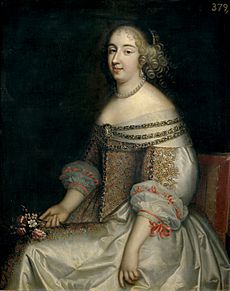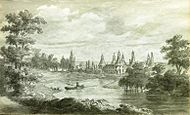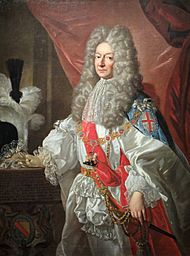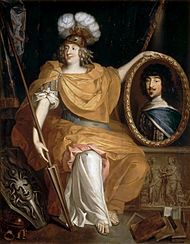Anne Marie Louise d'Orléans, Duchess of Montpensier facts for kids
Quick facts for kids Anne Marie Louise d'Orléans |
|
|---|---|
| La Grande Mademoiselle Duchess of Montpensier |
|

Portrait by Henri and Charles Beaubrun, 1655
|
|
| Born | 29 May 1627 Palais du Louvre, Paris, France |
| Died | 5 April 1693 (aged 65) Palais du Luxembourg, Paris, France |
| Burial | 19 April 1693 Royal Basilica, Saint Denis, France |
| House | Bourbon |
| Father | Gaston, Duke of Orléans |
| Mother | Marie, Duchess of Montpensier |
| Religion | Roman Catholicism |
| Signature | |
Anne Marie Louise d'Orléans, Duchess of Montpensier, often called La Grande Mademoiselle, was a very important French princess. She was born on May 29, 1627, and died on April 5, 1693. She was the only daughter of Gaston, Duke of Orléans, who was the brother of King Louis XIII.
Mademoiselle was one of the richest heiresses in history. She never married or had children. She left her huge fortune to her cousin, Philippe I, Duke of Orléans. Many important people from royal families wanted to marry her, like Charles II of England and Afonso VI of Portugal. But she fell in love with a nobleman named Antoine Nompar de Caumont. She asked King Louis XIV for permission to marry him. This caused a big scandal because he was not of royal birth. Marrying someone of a lower rank was called a mésalliance.
She is also remembered for her part in a civil war in France called the Fronde. She helped bring the famous composer Jean-Baptiste Lully to the king's court. She also wrote her own memories, called Mémoires.
| Top - 0-9 A B C D E F G H I J K L M N O P Q R S T U V W X Y Z |
Early Life of a French Princess
Anne Marie Louise d'Orléans was born at the Louvre Palace in Paris on May 29, 1627. Her father was Gaston, Duke of Orléans. He was the oldest living brother of King Louis XIII. This meant he was known as Monsieur at court.
Her mother, Marie de Bourbon, Duchess of Montpensier, died just five days after Anne Marie was born. This made the newborn Anne Marie the new Duchess of Montpensier. She inherited a massive fortune. This included several duchies and a sovereign principality.
As the oldest daughter of Monsieur, Anne Marie Louise was called Mademoiselle from birth. Because she was the granddaughter of a French King, Henry IV, King Louis XIII gave her a special title. She was called petite-fille de France, which means "Granddaughter of France".
Mademoiselle moved from the Louvre to the Tuileries Palace. She was cared for by Madame de Saint Georges, who was a governess for royal children. She taught Mademoiselle to read and write. Mademoiselle always felt very important. She once said her grandmother was "not a queen," meaning she didn't consider her maternal grandmother a true royal.

Mademoiselle was very close to her father, Gaston. Gaston often disagreed with King Louis XIII and his chief advisor, Cardinal Richelieu. Gaston even secretly married Marguerite of Lorraine without the king's permission. This was a problem because a royal prince needed the king's approval to marry. The king annulled the marriage, and Gaston was sent away from court.
As a child, Mademoiselle lived with her governess. Gaston lived at Château of Blois, and Mademoiselle visited him often. After his secret marriage, she didn't see her father for two years. When they finally met again, the seven-year-old Mademoiselle was overjoyed. She learned that Cardinal Richelieu, who was her godfather, was behind her father's exile. Mademoiselle would then sing funny songs about the cardinal when he was around.
When Louis XIV was born in 1638, Mademoiselle, who was determined, decided she would marry him. She called him "her little husband," which amused King Louis XIII. Richelieu later told her off for these comments. Her father wanted her to marry someone else, but that marriage never happened.
In 1643, Mademoiselle's governess died. Her father chose Madame de Fiesque as the new governess. Mademoiselle was sad about her old governess and didn't like having a new one. She once locked Madame de Fiesque in her room.
Just before he died in May 1643, King Louis XIII forgave Gaston. He allowed Gaston's marriage to Marguerite to be official. Gaston and Marguerite were then welcomed at court.
Marriage Prospects and the Fronde
After Louis XIII died, his wife, Queen Anne, became regent for their young son, Louis XIV. Mademoiselle considered marrying Holy Roman Emperor Ferdinand III in 1646. But Queen Anne, influenced by her advisor Cardinal Mazarin, ignored Mademoiselle's wishes. Louis XIV and his younger brother, Philippe, were too young to marry. Queen Anne suggested her own brother, but Mademoiselle refused. She was "the wealthiest single princess of Europe" but had no suitable marriage offers.
Mademoiselle played a big part in a French civil war called the Fronde. This war had two main parts. The first part was about taxes and the power of the Parliament of Paris. The second part involved noble families. People also opposed the influence of Cardinal Mazarin.
The first part of the Fronde ended in 1649. The court returned to Paris with celebrations. Mademoiselle got smallpox but recovered. She became friends with Claire Clémence de Brézé, the wife of a rebel leader named the Grand Condé. Mademoiselle helped make peace in the city of Bordeaux. This made Queen Anne see her as someone who supported the rebels.
There was a chance Mademoiselle might marry the Prince of Condé when his wife became very ill. Mademoiselle thought about it because she would still be a very important person at court. Also, her father got along well with Condé. But these plans failed when Condé's wife got better.
In 1652, another Fronde began, this time involving royal princes. Cardinal Mazarin was in exile. The city of Orléans, which was named after Mademoiselle's father's duchy, wanted to stay neutral in the war. Mademoiselle decided to go to Orléans herself to represent her father and help.
When Mademoiselle arrived at Orléans, the city gates were locked. She shouted for them to open, but they didn't. A boatman offered to take her to a gate by the river. Mademoiselle climbed into the boat and then through a gap in the gate. She entered the city and was welcomed like a hero. People carried her through the streets on a chair. She later said it was an amazing moment.
She stayed in Orléans for five weeks, calling it "my town." She returned to Paris in May 1652. Paris was in a panic because of a battle. Mademoiselle, to help the Prince of Condé enter the city, fired cannons from the Bastille at the king's army. Cardinal Mazarin famously said, "with that cannon, Mademoiselle has shot her husband." This meant she had ruined any chance of marrying the king.
Exile and Return to Court
Fearing for her safety, Mademoiselle left Paris for her home at Saint-Fargeau. She stayed in exile until 1657, when she was welcomed back to court. She brought her governess and another lady with her.

She had never been to Saint-Fargeau before and found the building needed a lot of work. She stayed in a smaller house nearby at first. She then moved into Saint-Fargeau for four years and began to improve the building. She hired François Le Vau, the brother of a famous architect, to redesign the outside. These changes were later lost in fires.
Even though she was in exile, she still visited her father at Château of Blois. At Saint-Fargeau, she started writing a small biography. She also looked into her money. She found out her father had not been honest with her finances. She was 800,000 livres in debt. Her grandmother also tricked her into giving away money. This made her relationship with her father worse. But in 1656, when her father was forgiven for his problems, Mademoiselle also decided to forgive him. They became close again.
When her father was welcomed back to court, Mademoiselle could return too. She went to Sedan in July 1657, where the court was. She hadn't seen her family in five years. They welcomed her with forgiveness and even complimented her looks.
She wrote about herself that year, saying she was "neither fat nor thin" and "looked healthy." She also met Christina of Sweden, a former queen, and found her "most extraordinary."
| "Being born important and having lots of money should make you happy... but many people who have these things are not happy. My own life shows this. " |
| Mademoiselle on her wealth |
At court, her cousins Louis XIV and Philippe were teenagers. Mademoiselle's role in the Fronde had ruined her dream of marrying Louis. Philippe, though, seemed to flirt with her. Mademoiselle thought about it but later said he always stayed close to his mother "like a child."
Mademoiselle became ill in Paris in September 1657. During her illness, she bought the Château d'Eu from her aunt. She then returned to Saint-Fargeau for Christmas.
In February 1660, her father Gaston died. As his oldest daughter, Mademoiselle inherited a large fortune, adding to her already huge wealth. Because she was in mourning, Mademoiselle could only attend the official wedding of Louis XIV to Maria Theresa of Austria. However, she went to the earlier ceremony in secret. The next royal wedding was between Philippe, the Duke of Orléans, and Princess Henrietta of England in March 1661. Mademoiselle was there with other court members.
Philippe and Henrietta had a difficult marriage. Mademoiselle was the godmother of their youngest child, Mademoiselle de Valois, born in 1670. When Henrietta died in 1670, Louis XIV asked Mademoiselle if she wanted to take Henrietta's place as Philippe's wife. She said no.
Mademoiselle and her younger half-sister Marguerite Louise were close. They would go to the theater and attend Mademoiselle's social gatherings.
Marguerite Louise later asked Mademoiselle to help with a marriage proposal from the Grand Prince of Tuscany in 1658. Mademoiselle was asked to make sure it happened.
Marguerite Louise was happy at first about marrying, but then she became upset when Mademoiselle no longer supported the match. After this, Marguerite Louise started acting strangely. She shocked the court by going out alone with her cousin Prince Charles of Lorraine, who became her boyfriend. Her marriage by proxy didn't change her behavior. She even tried to run away, but Mademoiselle stopped her.
In 1663, Louis XIV again asked Mademoiselle to arrange a marriage for his cousin. The groom was Alfonso VI of Portugal. But Mademoiselle refused. She said she would rather stay in France with her money and lands. She also heard that Alfonso was ill. Alfonso instead married someone else.
An angry Louis ordered her to return to Saint-Fargeau for disobeying him. This "exile" lasted about a year. During this time, she began to fix up the Château d'Eu and started writing her memories. She appealed to Louis about her health, and he allowed her to return to court. Louis then suggested she marry Charles Emmanuel II, Duke of Savoy. Mademoiselle seemed very interested, but Charles Emmanuel II was not. This was the last marriage proposal for la Grande Mademoiselle.
Lauzun and Later Years
In 1666, Mademoiselle was away from court and missed the parties at the Château de Fontainebleau. At these parties was a man named Antoine Nompar de Caumont, later the Duke of Lauzun. He was a poor nobleman but was known for his cleverness and good looks, even though he was very short. He was also a respected soldier. Lauzun once told Mademoiselle that a red ribbon in her hair was too "youthful" for her. Mademoiselle, who was proud, replied that "people of my rank are always young."
Soon, Mademoiselle fell deeply in love with Lauzun. In December 1670, she was the most important woman at court after the king's daughter. She asked Louis XIV for permission to marry Lauzun. Louis agreed, which surprised everyone at court. Queen Marie Thérèse and Philippe, the Duke of Orléans, did not like the idea and refused to sign the marriage contract. The wedding was set for December 21, 1670. Mademoiselle was very happy, calling those days the happiest of her life. She even called Lauzun "Monsieur le duc de Montpensier" to her friends.

Her happiness did not last. Because of pressure from the disapproving court, Louis XIV changed his mind. The engagement was called off on December 18. He said it would hurt his reputation. Mademoiselle was very upset, saying, "what cruelty..!" Louis replied that "kings must please the public." This ruined Mademoiselle's hopes of marriage.
Mademoiselle stayed in her rooms and didn't appear until early 1671. She then learned that Lauzun had been arrested without a clear reason. He was taken to the Bastille and then to the Pignerol fortress, where he stayed until 1681.
Mademoiselle was determined to free Lauzun. She asked Madame de Montespan, the king's mistress, to help convince the king. Lauzun's release came at a high price. Mademoiselle had to sell two of her most valuable lands: the principality of Dombes and the County of Eu. These lands were given to Louis Auguste de Bourbon, the king's favorite son with Madame de Montespan. Mademoiselle sold the lands on February 2, 1681, even though they were very important to her. She didn't know she was only buying Lauzun's release and the right for him to live on her estates in exile.
Lauzun was freed on April 22, 1681. He had to live quietly at Bourbon before returning to Paris, but not to court. He lived at the Hôtel de Lauzun in March 1682. After Queen Marie Thérèse died in July 1683, Mademoiselle and Lauzun, who had been on bad terms, briefly came together in their sadness. Soon after, they had one last meeting. Mademoiselle then retired to her Paris home, the Luxembourg Palace.
Death and Burial
Mademoiselle became ill on March 15, 1693. Lauzun asked to see her, but she refused to let him in. She died at the Luxembourg Palace in Paris on April 5, 1693. As a "Granddaughter of France," a title she cherished, she was buried at the Basilica of Saint-Denis outside Paris on April 19. At her funeral, people said she was "the wealthiest single princess of Europe." During the ceremony, the urn holding her internal organs exploded, causing people to flee because of the smell. The ceremony continued, and people joked that it was "another jest at the expense of Mademoiselle."
Images for kids
See also
 In Spanish: Ana María Luisa de Orleans para niños
In Spanish: Ana María Luisa de Orleans para niños



